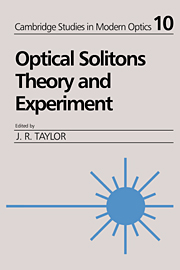Book contents
- Frontmatter
- Contents
- List of contributors
- Preface
- 1 Optical solitons in fibers: theoretical review
- 2 Solitons in optical fibers: an experimental account
- 3 All-optical long-distance soliton-based transmission systems
- 4 Non-linear propagation effects in optical fibres: numerical studies
- 5 Soliton–soliton interactions
- 6 Soliton amplification in erbium-doped fiber amplifiers and its application to soliton communication
- 7 Non-linear transformation of laser radiation and generation of Raman solitons in optical fibers
- 8 Generation and compression of femtosecond solitons in optical fibers
- 9 Optical fiber solitons in the presence of higher-order dispersion and birefringence
- 10 Dark optical solitons
- 11 Soliton-Raman effects
- Index
5 - Soliton–soliton interactions
Published online by Cambridge University Press: 21 October 2009
- Frontmatter
- Contents
- List of contributors
- Preface
- 1 Optical solitons in fibers: theoretical review
- 2 Solitons in optical fibers: an experimental account
- 3 All-optical long-distance soliton-based transmission systems
- 4 Non-linear propagation effects in optical fibres: numerical studies
- 5 Soliton–soliton interactions
- 6 Soliton amplification in erbium-doped fiber amplifiers and its application to soliton communication
- 7 Non-linear transformation of laser radiation and generation of Raman solitons in optical fibers
- 8 Generation and compression of femtosecond solitons in optical fibers
- 9 Optical fiber solitons in the presence of higher-order dispersion and birefringence
- 10 Dark optical solitons
- 11 Soliton-Raman effects
- Index
Summary
Introduction
In a communication system, it is desirable to launch the pulses close to each other so as to increase the information-carrying capacity of the fibre. But the overlap of the closely spaced solitons can lead to mutual interactions and therefore to serious performance degradation of the soliton transmission system. This has been pointed out independently by three groups (Chu and Desem, 1983a; Blow and Doran, 1983; Gordon, 1983).
Karpman and Solov'ev (1981) first considered the two-soliton interaction in their study of the non-linear Schrödinger equation (NLS) by means of single-soliton perturbation theory. Although they did not have optical fibre transmission in mind their results are applicable to fibres since the soliton propagation in optical fibres are described by the same equation. However, their method is restricted to large soliton separation only.
Our numerical investigations (Chu and Desem, 1983a) show that soliton interaction can lead to a significant reduction in the transmission rate by as much as ten times. At about the same time, Blow and Doran (1983) showed that the inclusion of fibre loss also leads to dramatic increase of soliton interactions. Gordon (1983) derived the exact solution of two counter-propagating solitons (of nearly equal amplitudes and velocities) and analysed the interaction by obtaining the approximate equations of motion corroborating the results of Karpman and Solov'ev (1981).
A considerable amount of research effort has been spent on the reduction of soliton interactions.
- Type
- Chapter
- Information
- Optical SolitonsTheory and Experiment, pp. 107 - 151Publisher: Cambridge University PressPrint publication year: 1992
- 6
- Cited by



